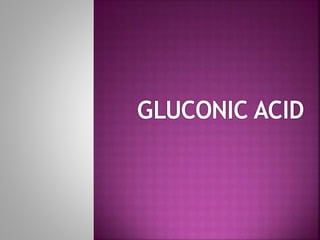
Gluconic acid
- 2. Gluconic acid is used as a mild acidulant in metal processing, leather tanning and foods. Sodium gluconate is widely used as a sequestering agent to prevent the precipitation of lime soap scums on cleaned products. Calcium gluconate is widely used in calcium therapy.
- 3. Gluconic acid is manufactured only by submerged fermentation process. The fungus used is a strain of Aspergilllus niger. Inoculum consist of either a sporulated culture or spores germinated in seed tank. Each type of inoculum has special advantages not seen in others. The acid is quickly neutralised upon excretion by the fungus. Therefore, the fermented broth contains either calcium or sodium gluconate.
- 4. The raw materials are D-glucose and oxygen. The glucose substrate may be supplied as a solution of crystalline glucose. Alternatively ,it may be added as a syrup obtained from starch or crude starchy matrials by the action of the α-amylase followed by the amyloglucosidase. The glucose concentration that can be handled depends on whether the sodium or the calcium salt is to be prepared.
- 5. It is necessary to maintain the maximum concentration of oxygen dissolved in the solution. This is achived by the application of vigorous agitation with a turbomixer or by action of a cavitator. The greater the consumption of power by the agitator motor,the more dissolution of oxygen.
- 6. Pressure (atmospheres) Weight yield (%) 1 42.5 3 80.4 4 82.4 5 81.3 6 86.1 Yield of gluconate in relation to air pressure
- 7. Operating optimum fermentation conditions in the manufacture of calcium or sodium gluconate are: Temperature = 28-300C Aeration = 1 – 1.5 volumes air/volume solution/minute Agitation = vigorous Initial pH = ~6.5
- 8. At the end of the fermentation, fungal mycelium is filtered off from the solution. The mycelium is used for the recovery of glucose aerodehydrogenase. On the other hand ,the filtrate is used to recover calcium or sodium gluconate, gluconic acid, and glucono-δ-lactone.
- 9. Recovery of calcium gluconate is achieved by heating the filtrate with a slight excess of Ca(OH)2 , then decolourizing with carbon and filtering. On cooling to a temperature below 200C and seeding with calcium gluconate crystals, the compound readily gets crystallized. A second crop of crystals of calcium gluconate is obtained by the evaporation of mother liquors through heating about 10-15 per cent volume followed by treatment with carbon, filtration and chilling.
- 10. To recover gluconic acid and its delta lactone,calcium is precipitated by the addition of a stoichiometric quantity of sulfuric acid. Calcium sulfate is filtered off and the filtrateis decolourized with carbon. After the removal of carbon, the acid solution is subjected to a concentration of 50 per cent acid strength. The product, thus obtained is a mixture of free gluconic acid and its γ- and δ-lactones.
- 11. Crystals separating from a gluconic acid solution at a temperature below 300C and preferably near 00C, are principally of gluconic acid. Crystals separating from solution at a temperature between 30-700C are of δ-lactone. Finally , γ-lactone crystallizes out at a temperature above 700C.
- 12. SHUHAIBA .K 2nd yr MFT